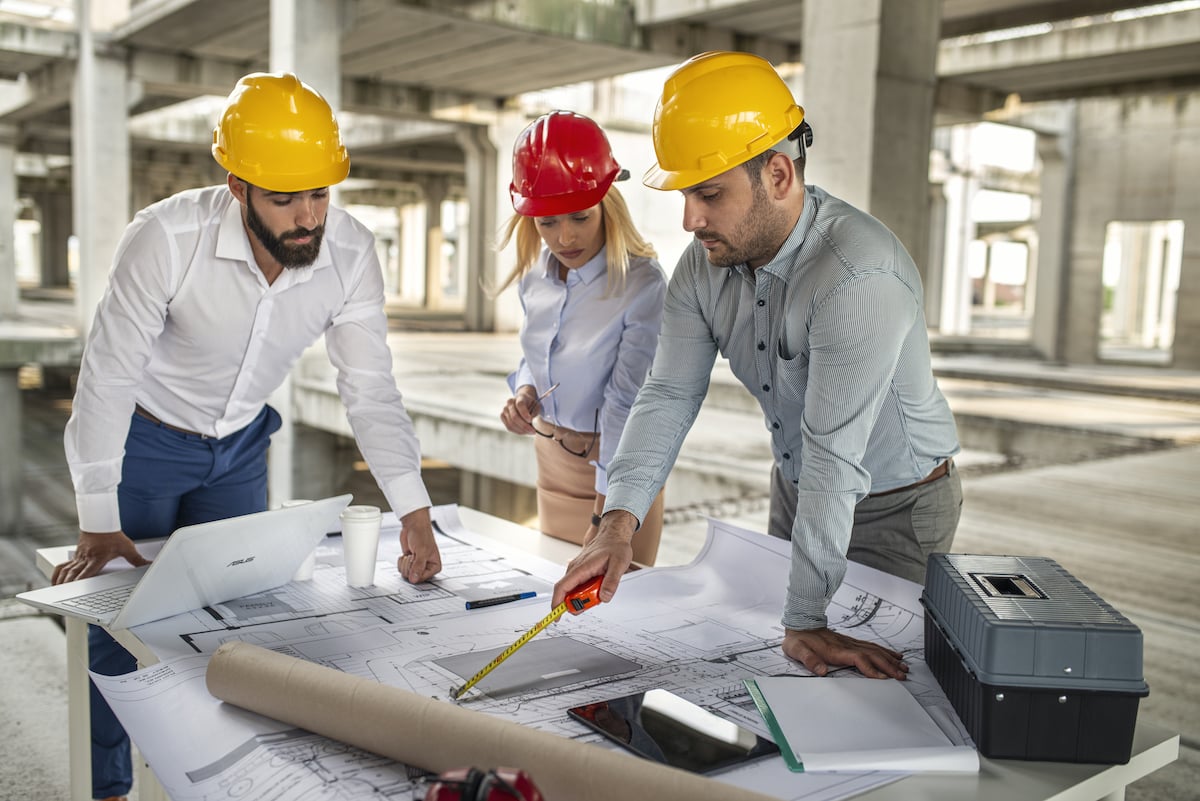Architect Guide to Eco-Friendly Building Materials
Architect Guide to Eco-Friendly Building Materials
Blog Article
Comprehending the Diverse Profession Paths Available for Aspiring Architect
As an ambitious Architect, you have a globe of profession courses waiting on you. Each path supplies distinct obstacles and possibilities to use your creative thinking and technological knowledge. Whether you're drawn to typical design or the subtleties of sustainable style, there's a particular niche that aligns with your passions. Recognizing these varied choices can form your professional trip, yet which direction will you pick to explore initially?
Conventional Design: Designing Structures and structures
Traditional architecture concentrates on developing buildings and structures that blend functionality with aesthetic appeal. As you explore this area, you'll appreciate the elaborate balance between type and purpose. You'll discover to attract ideas from historical styles, integrating aspects like balance, materials, and craftsmanship. Your styles can show cultural heritage, showcasing neighborhood practices while fulfilling modern needs.
You'll develop skills in composing, model-making, and website evaluation, permitting you to envision and interact your ideas properly. Engaging with clients, you'll need to comprehend their vision and equate it into feasible designs.
Furthermore, constructing codes and sustainability practices are important in your job, ensuring your structures are secure and eco friendly. As you grow in your job, you'll find possibilities in household, industrial, or perhaps remediation jobs, each offering distinct obstacles. Welcoming conventional design leads the way for a satisfying profession that pays tribute to the past while shaping the future.
Urban Planning: Forming Neighborhoods and Public Spaces
As an aspiring Architect, you can play a crucial role as an urban organizer, transforming just how communities operate and interact. By utilizing community involvement techniques, you'll ensure that residents have a voice in shaping their environment. And also, incorporating lasting style concepts will help produce spaces that not just fulfill today's requirements yet likewise secure the future.
Role of Urban Planners
While lots of might assume of architects as the single dreamers behind buildings, city coordinators play a crucial role in forming the more comprehensive landscape of areas and public spaces. By collaborating with different stakeholders, you'll help develop parks, transport systems, and residential locations that advertise social communication and accessibility. Your proficiency in spatial design and neighborhood dynamics enables you to visualize future growth while preserving social heritage.
Neighborhood Engagement Approaches
Effective neighborhood involvement strategies are crucial for city coordinators to assure that the voices of residents are heard and valued in the planning process. To promote purposeful discussion, you should prioritize open forums and workshops where community members can reveal their ideas and worries. By proactively incorporating and listening responses, you'll create rooms that show the neighborhood's demands, ultimately leading to more sustainable and successful urban settings.
Sustainable Style Concepts
When making metropolitan areas, integrating sustainable style principles is essential for developing atmospheres that flourish both environmentally and socially. You should begin by concentrating on power effectiveness, using products that minimize waste and promote recycling. Consider incorporating green areas, like gardens and parks, to enhance biodiversity and enhance air quality. Advertising walkability and public transport can decrease reliance on autos, fostering a healthier community.
Creating with water preservation in mind is additionally vital-- consider rain yards and absorptive surface areas to take care of stormwater. Including community members during the planning procedure assurances that the spaces you develop fulfill their needs and motivate social communication. By accepting these concepts, you'll add to dynamic, lasting city landscapes that profit every person.

Landscape Design: Developing Sustainable Outside Settings
As you discover landscape style, you'll find crucial style concepts that develop lovely and useful exterior areas. Sustainable practices play a crucial duty in making sure these atmospheres flourish while decreasing environmental impact. Plus, you'll locate a selection of job chances that permit you to make a genuine difference in exactly how individuals interact with nature.
Design Concepts in Landscape
Comprehending style concepts in landscape design is vital for producing sustainable exterior atmospheres that balance with nature. You'll require to consider aspects like scale, proportion, and balance to ensure your layouts feel natural and inviting. In addition, pay interest to seasonal modifications, developing with materials that complement the surroundings year-round.
Lasting Practices Overview
Sustainable practices in landscape architecture not only focus on looks but also prioritize eco-friendly health and wellness and resource preservation. By integrating indigenous plants, you improve biodiversity and lower the demand for chemical plant foods and chemicals. Applying effective irrigation systems assists preserve water and lessens runoff, shielding nearby ecosystems. You can create spaces that advertise dirt wellness, such as utilizing natural materials and exercising permaculture principles. In addition, including green infrastructure, like rainfall yards and permeable pavements, aids in stormwater monitoring and reduces urban heat. When you produce outside atmospheres with sustainability in mind, you add to a healthier planet and supply rooms that cultivate community link. Inevitably, these techniques assure your designs benefit both individuals and the setting for years to find.
Job Opportunities Expedition
With a strong structure in lasting practices, landscape architecture supplies a range of career paths that allow you to make a significant impact on the environment. Urban planners usually team up with landscape engineers to create environment-friendly rooms in city settings, improving city livability. If you're enthusiastic concerning education and learning, consider becoming a landscape design educator, inspiring future generations.
Lasting Design: Concentrating on Eco-Friendly Practices
As you explore your job in design, welcoming environment-friendly techniques can establish you apart in a competitive field. Lasting style focuses on producing buildings that minimize ecological impact while enhancing owner well-being. By including eco-friendly materials, energy-efficient systems, and lasting structure methods, you'll contribute to a greener future.
Start by gaining knowledge of green accreditations like LEED or BREEAM, which can strengthen your credentials. Consider just how all-natural light, ventilation, and thermal effectiveness can enhance design. Work together with engineers and ecological experts to introduce solutions Click Here that lower waste and save sources.
Do not neglect browse around this site the significance of neighborhood involvement-- interesting neighborhood stakeholders can inspire styles that balance with the atmosphere. As customers increasingly focus on sustainability, your competence in environment-friendly methods will not only attract projects but likewise meet your enthusiasm for responsible design. Embrace this crucial facet of the career, and see your career flourish.
Historic Preservation: Safeguarding and Restoring Cultural Heritage
While you commence on your building trip, consider the important role of historic conservation in keeping our social heritage. This area concentrates on the security and remediation of considerable buildings, sites, and structures that tell the stories of our past. By participating in historic preservation, you'll assist protect the architectural heritage that shapes area identification.
As a historic preservation Architect, you'll analyze historic importance and examine the condition of frameworks. You'll work very closely with conservationists and chroniclers to guarantee authentic restoration strategies are utilized. This job course allows you to mix imagination with research, allowing you to design remedies that respect initial materials and workmanship.
Your work not only adds to sustainability by reusing existing buildings yet also promotes a feeling of pride within areas. Accepting this path will aid you become a guardian of see this page history, maintaining the stories and looks that enrich our lives.
Interior Design: Enhancing Indoor Spaces
Historical conservation and interior design both share a commitment to boosting the built environment, but they concentrate on different facets. While historic preservation highlights keeping a framework's historical and social worth, indoor design nos in on maximizing interior spaces for capability and aesthetic appeals.
As an aspiring Architect, you'll locate that interior style enables you to mix creative thinking with technological abilities. You'll make rooms that not just look great however additionally promote convenience and efficiency. This area entails understanding just how light, color, and products engage within an area, influencing mood and functionality.
You'll deal with various projects, from household homes to business workplaces, making sure that each atmosphere satisfies the demands of its owners. By prioritizing user experience, you can transform interiors into functional and inspiring areas, making a significant influence on exactly how individuals interact with their environments. Welcome the chance to improve interior atmospheres and shape the means individuals live and work.
Industrial Style: Combining Functionality With Aesthetic Appeals
Industrial layout plays a vital duty in creating products that perfectly mix looks with performance, ensuring that what you make use of daily is not only aesthetically appealing however also practical. As an ambitious Architect, you could immerse on your own in this area, focusing on creating everything from furnishings to customer electronics. Your job entails recognizing individual requirements, products, and manufacturing procedures, permitting you to create cutting-edge remedies that improve daily experiences.
In industrial layout, you'll often collaborate with producers, marketers, and designers, ensuring that your layouts are not just stunning yet also feasible. You'll learn to stabilize type and function, prioritizing usability without giving up style. By developing your abilities in sketching, 3D modeling, and prototyping, you'll be well-appointed to bring your ideas to life. This career course offers a vibrant atmosphere where creativity fulfills functionality, making it a fulfilling selection for designers thinking about forming the products of tomorrow.
Often Asked Concerns
What Educational Qualifications Do I Required to End Up Being an Engineer?
To come to be an architect, you'll require a specialist degree in style, typically a Bachelor's or Master's. Furthermore, you'll have to finish a teaching fellowship and pass the Architect Registration Assessment to exercise legitimately.
Exist Qualification Requirements for Various Building Career Paths?
Yes, there're accreditation requirements for different architectural paths. Architect. You'll need to pass examinations, full internships, and sometimes go after specialized training, depending upon your selected focus, like landscape architecture, city style, or historic conservation
What Software Skills Are Crucial for Designers Today?

Exactly How Can I Gain Practical Experience While Examining Design?
You can acquire functional experience by interning at architectural firms, taking part in style competitions, offering for community tasks, or teaming up with schoolmates on real-world jobs. These possibilities boost your skills and build valuable links in the market.
What Work Opportunities Exist Outdoors Traditional Style Firms?
You can explore various task chances outside conventional style firms, like metropolitan planning, interior decoration, landscape design, construction administration, realty advancement, and even functions in sustainability consulting. Each offers special challenges and incentives.
Whether you're attracted to typical architecture or the nuances of lasting layout, there's a niche that straightens with your interests.When developing metropolitan spaces, including sustainable design principles is crucial for producing atmospheres that grow both environmentally and socially.As you explore landscape design, you'll uncover essential design principles that produce lovely and useful outside rooms.Recognizing design concepts in landscape architecture is vital for producing lasting outside atmospheres that balance with nature.In commercial layout, you'll often collaborate with suppliers, marketing experts, and designers, making sure that your styles are not only beautiful but also viable.
Report this page